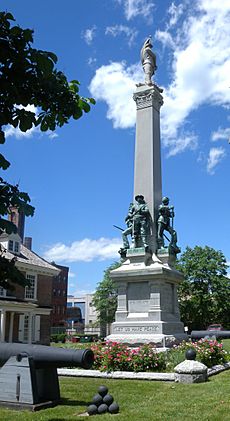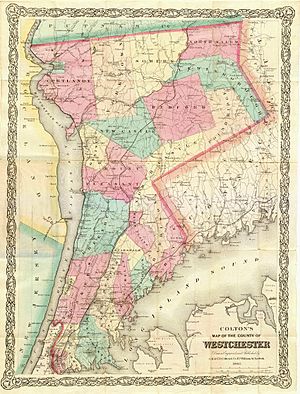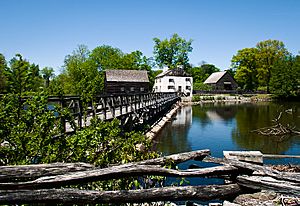History of Westchester County facts for kids
Westchester County is a place in New York State. Its history goes back a long way! People first settled here between the Hudson River and Long Island Sound in the 1600s. But people lived in this area even before that, during the ancient Archaic period. The towns and cities we know today really started to grow during the Industrial Revolution.
Contents
Ancient History of Westchester County
Long before Europeans arrived, Native American groups lived in what is now Westchester County. These people were part of the Algonquian peoples. They called themselves the Lenape, which means "the people." Their land, called Lenapehoking, stretched around the Delaware and Hudson Rivers.
Lenape Languages and Tribes
The Lenape spoke two related languages: Unami and Munsee. Munsee was spoken by the people living in present-day Westchester County and on Manhattan Island.
Old land records from when Europeans bought land tell us about the different tribes and where they lived:
- The Manhattans lived on Manhattan Island and in southern Westchester, near what is now Yonkers.
- The Weckquaesgeek tribe lived along the Hudson River. Their homes were near modern Dobbs Ferry, Tarrytown, and White Plains.
- The Siwanoy lived along the Long Island Sound coast. This area includes places like Pelham, New Rochelle, Larchmont, Mamaroneck, and Rye.
- Smaller Wappinger tribes, like the Tankiteke, Kitchawank, and Sintsink, lived in the northern parts of the county.
Colonial Era in Westchester
The first European explorers to visit the Westchester area were Giovanni da Verrazzano in 1524 and Henry Hudson in 1609. Dutch settlers arrived in the 1620s and 1630s. English settlers came from New England in the 1640s.
By 1664, the English took control of the area from the Dutch. Large parts of Westchester were set up as manors or patents. Manors were owned by one person, while patents were owned by partners. These owners leased land to farmers. They also provided important services to the farmers.
Westchester County was one of the first twelve counties in the Province of New York. It was created by the New York General Assembly in 1683. At that time, it also included what is now Bronx County.
Life in Westchester during the colonial period was simple. Roads were bad, so people traveled mostly by water. Settlers grew or made almost everything they needed on their farms. They traded wood, cattle, and food for things they couldn't make themselves. Over time, small home businesses, like making shoes and furniture, started up. This led to better roads and more travel. Taverns for travelers and ferries were also created. By 1775, Westchester was the richest and most populated county in the New York colony.
Westchester During the American Revolution
The American Revolutionary War greatly affected Westchester County. Families were often split, with some supporting the American Patriots and others remaining loyal to the British.
After the battles of Pell's Point and White Plains in 1776, the main American army headquarters was in Continental Village, north of Peekskill. The British were based in New York City. The area between Morrisania and the Croton River became "neutral ground." Both sides often raided and took supplies from this area.
Philipsburg Manor's Role
The Philipsburg Manor House was important during the war. British General Sir Henry Clinton used it as his headquarters in 1779. There, he wrote the Philipsburg Proclamation. This statement declared that enslaved people owned by Patriots would be free if they joined the British. It also said that Black people captured while fighting for the Patriots would not be freed.
After the war, Westchester County recovered quickly. Many large landowners had been Loyalists. Their lands were taken by the state and sold. This allowed many local farmers to buy the land they had been farming as tenants. In 1788, the county was divided into 20 towns. By 1798, the county's population was 24,000 people.
Westchester in the 1800s
In 1800, the first commercial toll road, the Westchester Turnpike, opened. It ran through Pelham and New Rochelle. Other toll roads followed. Around the same time, steamboats began operating on the Hudson River. These new ways to travel helped the economy grow.
Larger industries started, such as:
- Iron foundries in Peekskill and Port Chester.
- Brickyards in Verplank and Croton.
- Marble quarries in Ossining and Tuckahoe.
Big Changes: Water and Railroads
Two major developments in the early 1800s greatly changed Westchester and New York City: the building of the first Croton Dam and Aqueduct, and the arrival of railroads.
The Croton Dam and Aqueduct project began in 1837 and finished in 1842. The aqueduct carried water 41 miles (66 km) from Croton to reservoirs in Manhattan. This supplied water to New York City. Today, the Croton Aqueduct is a National Historic Landmark. It is seen as a great engineering achievement of the 1800s.
In the 1840s, the first railroads came to Westchester. The New York and Harlem Railroad reached White Plains in 1844. The Hudson River Railroad finished its line to Peekskill in 1849. The New York and New Haven Railroad also built its route through eastern Westchester.
Railroads often decided if a town grew or shrank. They also caused people to move from northern to southern Westchester. By 1860, the county's population was 99,000. Yonkers was the largest city. Many small downtown areas grew around railroad stations.

After the American Civil War, many wealthy people from New York City built large estates in Westchester. Some of these beautiful mansions are still preserved and open to the public today. These include:
- Lyndhurst in Tarrytown.
- Kykuit in Pocantico Hills.
- The Jay Heritage Center in Rye.
- Caramoor in Katonah.
- Glenview in Yonkers.
The expansion of New York City's water system also affected local development. New dams, bridges, and roads were built. To create new reservoirs, thousands of acres were flooded. This caused many towns north of White Plains to move. For example, the hamlet of Katonah was moved to higher ground when the New Croton Dam and its reservoir were built. In North Salem, the hamlet of Purdys moved when five percent of the town was covered by water.
In the late 1800s, Westchester's transportation and workforce attracted many factories. These were mostly along the Hudson River and Nepperhan Creek. Factories made things like:
- Pills and medicines in Ossining.
- Greenhouses in Irvington.
- Beer in Dobbs Ferry.
- Sugar, paving materials, and pipes in Hastings.
- Elevators and carpets in Yonkers.
In 1874, the western part of what is now Bronx County was transferred to New York City. This included the towns of Kingsbridge, West Farms, and Morrisania. In 1895, the rest of present-day Bronx County was also transferred. This included the Town of Westchester and parts of Eastchester and Pelham. Before that, a part of Eastchester became the city of Mount Vernon. In 1898, these annexed areas became the Borough of the Bronx. In 1914, The Bronx became its own county, Bronx County.
Westchester in the 1900s
During the 1900s, Westchester changed from a rural area to the suburban county we know today. With railroads and cars becoming popular, people could work in New York City and live in the countryside.
In 1907, the Bronx River Commission was formed. This group worked to improve the water quality of the Bronx River. Their efforts led to the creation of the Bronx River Parkway Reservation, finished in 1925. This was the first modern, multi-lane highway in North America. The success of this parkway encouraged the County government to create more parks, saving large areas of open space.
Playland in Rye opened in 1928. It was the first planned amusement park in the country. Westchester County still operates it today. The development of parks and parkways helped existing communities and encouraged new ones to grow. Homes were built on old estates and farms. New businesses appeared as more people moved in. White Plains became the county's main shopping area, with branches of many New York City stores.
After World War II, more homes were needed. Multi-story apartment buildings appeared in the county's cities. The demand for single-family houses also grew. By 1950, the total county population was 625,816.
Major interstate highways were built in Westchester during the 1950s and 1960s. These roads, along with the Tappan Zee Bridge, encouraged many big companies to move their headquarters to Westchester. Some of these companies included PepsiCo, General Foods, Ciba-Geigy, and IBM.
|




